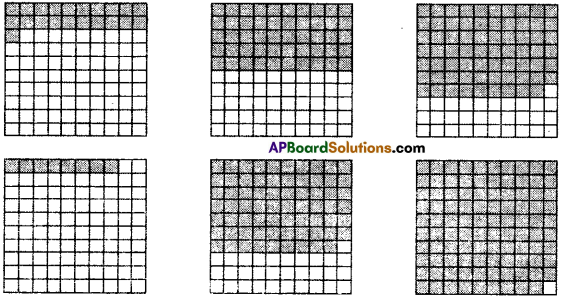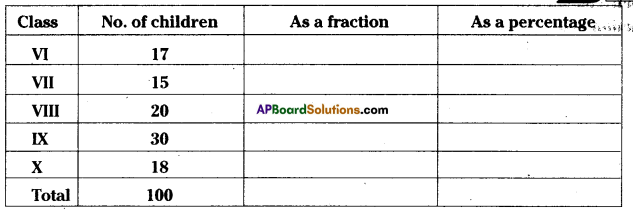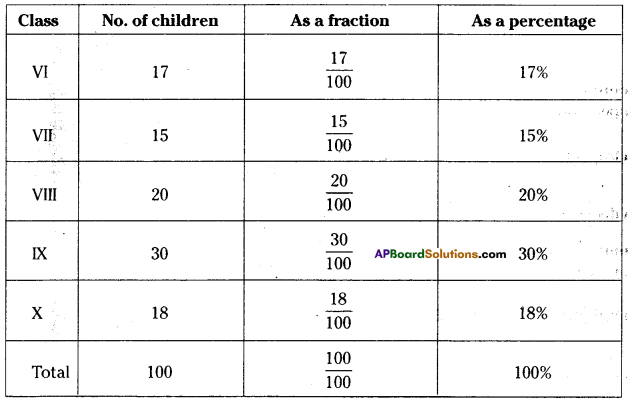AP State Syllabus AP Board 7th Class Maths Solutions Chapter 6 Ratio – Applications InText Questions and Answers.
AP State Syllabus 7th Class Maths Solutions 6th Lesson Ratio – Applications InText Questions
![]()
Try This
Question
Think of some real life situations in which you have to compare quantities in the form of a ratio. (Page No. 111)
Solution:
- Boys and girls ratio in a class.
- Number of matches won and lost by India at World Cup.
- Number of students come by bycycle and on foot.
![]()
Do This
Question 1.
40 benches are required to seat 160 Sfciidents. How many benches will be required to seat 240 students at the same rate ? (Page No. 116)
Solution:
Number of benches required to seat 160 students= 40
On one bench, the number of students that can be seated = \(\frac{160}{40}\) = 4 . 40
∴ For 240 students the number of benches required = \(\frac{240}{4}\)= 60
Question 2.
When a Robin bird flies, it flaps wings 23 times in 10 sec. How many times will it flap its wings in 2 minutes ? (Page No. 116)
Solution:
In 10 sec. Robin bird flaps for 23 times.
In 1 sec Robin bird flaps \(\frac{23}{10}\) times
In 2 minutes = 2 x 60 = 120 sec Robin bird flaps for = \(\frac{23}{10}\) x 120 = 276 times
![]()
Question 3.
The average human heart beats at 72 times per minute. How maiiy times does it beat in 15 seconds ? How many in 1 hour ? How many in a day ? (Page No. 116)
Solution:
Number of beats per 1 minute (60 seconds) = 72 times
Number of beats per 1 second = \(\frac{72}{60}=\frac{6}{5}\) times
Number of beats per 15 seconds = \(\frac{6}{5}\) x 15 =18 times
∴ Number of beats per 1 hour = \(\frac{6}{5}\) x 60 x 60 = 4320 times
∴ Number of beats per 1 day = 4320 x 24 = 103680 times.
Try This
Question 1.
Population of our country as per 2011 census is about 12 x 108 (120,00,00,000). If the popu-lation of our country increases by 3% every year what will be the population by 2012 ? (Page No. 126)
Solution:
Population in 2011 = 12 x 108
It increases by 3%
Population in 2012 = (100 + 3) % of 2011
= 103% of 12 x 108
= \(\frac{103 \times 12 \times 10^{8}}{100}\)
= \(\frac{1236 \times 10^{8}}{100}\)
= 12.36 x 108 .
![]()
Question 2.
i) Can you eat 75% of a dosa ? (Page No. 126)
Solution:
Yes.
ii) Can the price of an item go up by 90% ?
Solution:
Yes.
iii) Can the price of an item go up by 100% ?
Solution:
Yes.
![]()
Do This
Question 1.
Find the interestonasum of825O for3yearsat the rate of 8%perannum. (Page No. 138)
P = ₹ 8250 R = 8% T = 3 years
Interest =P x R% x T
I = 8250 x \(\frac{8}{100}\) x 3 .
Interest = \(\frac{198000}{100}\) = 1980
Question 2.
₹ 3000 is lent out at 9% rate of interest. Find the Interest which will be reèieved at the end of 2½ years. (Page No. 138)
Sol. P = ₹3000 R = 9% T = 2½ years = \(\frac{5}{2}\),
Interest = P x R% x T
3000 x \(\frac{9}{100} \times \frac{5}{2}\) = ₹675
Do This
Question
Given below are various grids of 100 squares. Each has a different number of squares coloured.
In each case, write the coloured and white part in the form of a 1) Percentage 2) FractIon and 3) Decimal (Page No. 121)

Solution:
I) Coloured squares = 21
as a percentage 21%
as a fraction = \(\frac{21}{100}\)
asadecimal = \(\frac{21}{100}\) =0.21
ii) Coloured squares = 50
as a percentage = 50%
asafraction = \(\frac{50}{100}=\frac{1}{2}\)
as a decimal = \(\frac{50}{100}\) = 0.50
![]()
iii) Coloured squares = 69
as a percentage = 69%
as a fraction = \(\frac{69}{100}\)
as a decimal = \(\frac{69}{100}\) = 0.69
iv) Coloured squares = 8
as a percentage = 8%
as a fraction = \(\frac{8}{100}=\frac{2}{25}\)
as a decimal = \(\frac{8}{100}\) = 0.08
v) Coloured squares = 70
as a percentage = 70%
as a fraction = \(\frac{70}{100}\)
as a decimal = \(\frac{70}{100}\) = 0.70
vi) Coloured squares = 99
as a percentage = 99%
as a fraction = \(\frac{99}{100}\)
as a decimal =\(\frac{99}{100}\) = 0.99
Question 2.
Look at the grid paper given below. It Is shaded In various designs. Find the percentage of each design (Page No. 122)


Solution:
(i) 19%
(ii) 40%
(iii) 34%
(iv) 7%
![]()
Question 3.
The strength particular of a school are given below. Express the strength of each class as a fraction, percentage of total strength of the school. (Page No.122)

Solution:

![]()
Try This
Question 1.
The C.P of 12 mangoes is equal to the selling price (S.P) of 15 mangoes. Find the loss percent. (Page No. 128)
Solution:
C.P. of 12 = S.P of 15
∴ Loss = 3
Loss percentage = \(\frac{3}{15}\) x 100% = 20%
